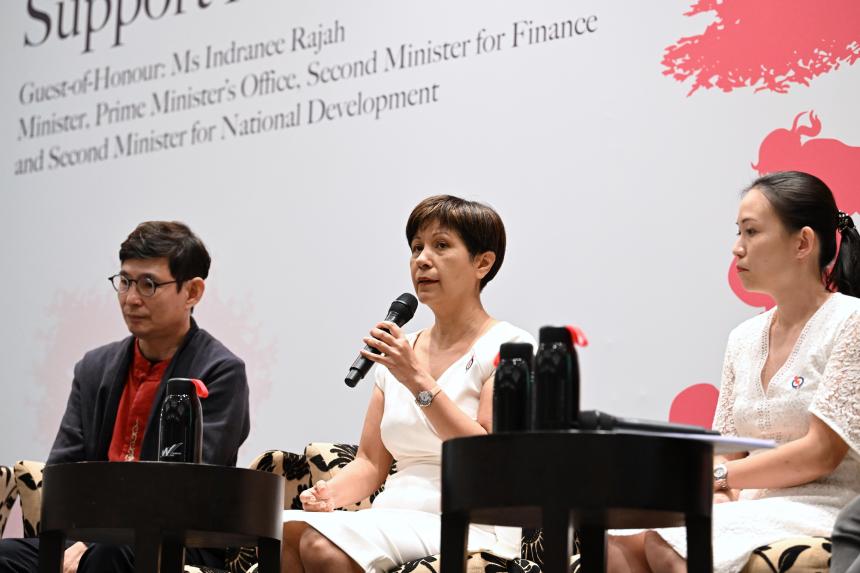SINGAPORE - Working from home is the most common type of flexible work arrangement in Singapore, according to a survey of 2,700 respondents, where over half of them have children.
Staggered working hours – which allow employees to vary their start and end times to suit their work and personal commitments – is the second-most common form of flexible work arrangement.
These were some of the results of a survey conducted from May 25 to June 19, 2023, by the research group in the People’s Action Party (PAP) Women’s Wing and the National Trades Union Congress’ Women and Family Unit, which was announced by organising chairman Gan Siow Huang at the PAP Women’s Wing Conference on Saturday.
Themed “Support for SG Families”, the conference was held at Paradox Singapore Merchant Court in Clarke Quay.
Another survey finding was that company size plays a part in allowing employees to work from home.
Sixty per cent of respondents in companies with more than 100 employees could work from home, whereas for those in companies with 25 or fewer employees, only 40 per cent could do so.
While the main benefit for employees who work from home is that they can better manage work and caregiving responsibilities, the survey also noted that three in 10 respondents were more efficient in the office than at home.
Speaking at a panel on the challenges faced by women, Minister in the Prime Minister’s Office and Second Minister for Finance and National Development Indranee Rajah said that if well designed, flexible work arrangements need not compromise productivity. Flexible work arrangements are a better approach than trying to mandate leave for every different situation.
She noted that government-paid paternity leave will be doubled from two to four weeks from 2024, to encourage more fathers to care for their children. Employers can choose to grant the additional two weeks of leave on a voluntary basis, and will be reimbursed by the Government. This is as the Republic is seeing fewer babies, said Ms Indranee.
Singapore’s total fertility rate (TFR) was 1.04 in 2022.
She also noted how families are coming under stress, due to the ageing population requiring more caregiving.
About 70 per cent of the 3,000-strong workforce at environmental services firm Chye Thiam Maintenance (CTM) are women. The company allows most of its full-time cleaning workers to choose how to fulfil their 44-hour work week.
Its retention rate of up to 90 per cent for its blue-collar workers helps to control costs in training new employees, said its chief executive Edy Tan.
Speaking at a panel on supporting women in their roles at home and work, Mr Tan said that as the environmental services industry is labour-intensive, CTM has also been looking at getting women to re-enter the workforce, by redesigning their role with flexible work arrangements. This is so they can fulfil caregiving responsibilities, while transiting back into the workforce with ease, he said.
Ms Gan, who is also Minister of State for Manpower and Education, noted that there are fewer opportunities to work from home for smaller companies with fewer than 25 employees.
Speaking on the sidelines after the conference, Ms Gan noted that there are other forms of flexible work arrangements, including flexi-time and flexi-load.
“We should help the smaller companies (do) job redesign (and) have HR capabilities, for them to be able to implement flexible work arrangements that work for their companies as well as for their employees,” she said.
Ms Sim Ann, PAP Women’s Wing chairman, noted that the conference is now in policy advocacy mode with this year’s theme of Support for SG Families, even as Singapore is facing a declining TFR, a rapidly ageing population and a tight labour market.
Supporting families, she said, requires a whole-of-society effort: Government must continue to place this high on the agenda; employers and industry leaders need to be facilitative; and men and women need to change mindsets about gender roles and how caregiving and household duties should be shared.
But whole-of-society solutions must be signed off by the women, she added.
“They must make sense to: women balancing work and careers with being wives and moms; women, whether married or single, caregiving for parents or other family members; older women being tapped to care for their grandchildren while seeking to pursue their own interests; younger women charting out their lives and wondering what choices to make and whether the trade-offs are worthwhile.
“Without women’s participation and inputs, we cannot find lasting breakthroughs – especially to the long-term challenge of low TFR.”
Editor’s note: This article has been edited for accuracy.

